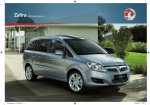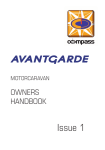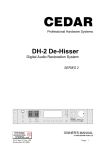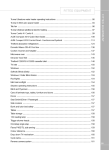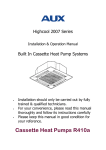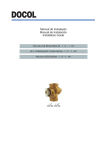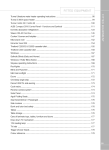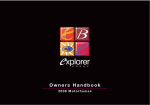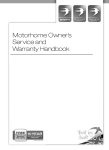Download Quick User Guide Macclesfield Motorhome Hire
Transcript
Quick User Guide for the Swift Escape 664 Macclesfield Motorhome Hire 07825 702020 [email protected] www.mohohire.com Height 2.85m Length 6.72m Overall Width (Mirrors Folded) 2.24m Pre-Start Checks There are a lot of items that need to be safely stowed before driving the vehicle, please follow this checklist – it starts outside and works forward through the vehicle. 1. Gas off 2. Bike rack secure 3. Mains cable stowed and cupboard door secured 4. Step retracted 5. Levelling ramps stowed away 6. TV aerial down, and red spot to the rear (to avoid being caught by overhead branches) 7. Table leg clipped to the floor 8. TV bracket locked (screw to tighten and lock arms in place) 9. Fridge; set to 12v, contents secure, and door latched 10. All overhead cupboards shut and locked 11. Roof lights closed and locked down 12. Gas hob lid down 13. Work surfaces clear of loose items 14. Windows closed and locked (at motorway speeds it may rip them off completely) 15. Shower head placed in tray (to prevent falling off and cracking tray) 16. Toilet cassette in closed position 17. Bathroom window closed and door locked shut 18. Driver and passenger seat rotated forward and lockedFresh water – check levels and fill as required 19. Waste water – check levels and empty as required 20. Empty toilet cassette into chemical waste facilityAdjust wing mirrors (can you see the rear wheels?) 21. Consider the extra length of vehicle, and run wider when cornering 22. The camper is 2.85m or 9’ 4” high Fiat Ducato Cab Bonnet release Fuel filler cap DIESEL FUEL ONLY Emergency toolkit 2 x 12v power sockets for GPS MP3 ‘mini jack’ stereo input 5 speed manual gearbox Central locking (night time) Lockable storage Driving a Large Vehicle The dimensions of this vehicle are printed on the front cover. Width: Although it appears big, the van is actually not much wider than an ordinary car. The exterior mirrors are the widest part of the vehicle, and they give you a good “feel” for the width. Be careful though, about getting too close to trees and hedges. Strong branches hidden among the leaves frequently scratch the sides of motorhomes. Some countries require drivers to fold external mirrors inward when parked. Length: The rear wheels are significantly further back from the driver than in a normal car. As a result it is very easy to turn too soon and have the rear wheels bumping over the kerb, or worse, to scrape the side of the van against something. The trick is to turn later, running wider on corners and at junctions. Adjust each external mirror so that you can see both the kerb and the rear wheel. Then as you turn, glance in the mirror, and you will quickly learn when to turn. Height: Arches or low bridges are an obvious hazard. Wheel and kerb Also watch out for low roofs, and overhanging tree branches, particularly when you are squeezing into the side of a narrow road to avoid an oncoming vehicle and your attention is focused at ground level. Parking: The vehicle is too tall to fit in most multi-storey car parks, and longer than most on-street parking bays. If you effectively occupy two parking bays, it is safer to buy two parking tickets. Some car parks have high-level barriers that are open during the day, but are closed in the evening, and could prevent your tall vehicle from leaving. Reversing: Ask your passenger to walk and guide you. Explain that you can see them only if they can see you in the mirrors. Open both front windows, so you can hear them. Fuel Economy: Motorhomes are not very aerodynamic. You will use about 20% less fuel at 60mph than at 70. Change up at 2000rpm for best economy. Passengers must remain seated with seat belts fastened whenever the vehicle is moving. Length (no bike rack) – 6.72m (22’ 1”). Width (mirrors folded) – 2.24m (7’ 4”) Height (no aerial) – 2.85m (9’ 4”) External Step The retractable step simply pulls out, but to return it, you must lift and push at the same time. There is an audible alarm if you start the engine without retracting the step. Fire Safety Fire extinguisher located behind passenger front seat Fire blanket located in kitchen area Never Try To Move A Burning Pan Outside – Use The Fire Blanket Instead If the battery needs replacing, turn the whole alarm anticlockwise to open. Smoke detector located near habitation door Levelling If the motorhome is not level when parked, it can prevent the fridge from working, and affect the drainage of water from the shower trays. More importantly, it can make sleeping uncomfortable. Levelling ramps are provided to assist in levelling the motorhome. These can be used to lift either one end of alternatively one side. Slowly drive forward onto the ramps with your passenger directing you from outside of the vehicle. Try not to drive too quickly up the ramps. If you overshoot, and drive off the end, they may flip over and become wedged under the vehicle. Once you have levelled up, make sure that the handbrake is firmly applied and you leave the vehicle in 1st gear to ensure that the vehicle does not move either way. Storage There is a hatch giving access to the storage under the bed. Anything that is too big to pass through this hatch, may be loaded by lifting up the bed inside. Access under bed inside Water The motorhome has two separate on-board water tanks, 65 litres for fresh tap water and 70 litres for waste water. This water is exclusively what has gone down the drains of either the sink or the shower. It does not include the toilet waste - which is completely separate. We recommend NOT to drink the fresh water from the tank, unless it has been boiled. The fresh water is filled through the filler cap located on the left side of the vehicle at the rear, using the hose supplied. When full the tank weighs 65kg so you may want to part fill it to save weight. Water is electrically pumped from the tank to the taps, shower and toilet flush. The pump creates a small positive pressure in the system and then automatically switches off (you may hear a vibration noise whilst the pump is working). When any tap is opened, the pressure falls and the pumps runs again until the pressure is restored when the tap has been turned off. If the pump seems to be running for a long period of time, this may indicate that a tap is open, there is a leak in the system, or a fault with the pump. Please check all taps and visually check underneath the vehicle to see if any water is being dumped via the overflow valve. The waste water tank collects water from the sink and shower drains and is located underneath the vehicle at the rear on the left. This tank can be emptied by opening the plastic grey tap, and allow the water to drain out. This water should be emptied over a designated motorhome waste point (usually a grid which you drive over). Before leaving a campsite, consider whether the water tanks and toilet need filling or emptying. If you neglect emptying the grey water tank you may add up to 70kg of unnecessary weight to the vehicle, and you may see grey water returning to the shower tray. Don’t put hot fat or solid material down the sink drain, as the pipes are narrow and will block easily. Toilet Turn on the water pump to enable the electric flush. The whole toilet bowl can swivel to make a little more elbow room. The outlet in the bottom of the toilet bowl is normally closed with a sealing “blade”. Move it out of the way by sliding the lever at the front. After use, flush the toilet using the central button, and close the blade by pushing the lever backwards. (Otherwise if you hit a sleeping policeman too fast, the toilet contents could be ejected.) Toilet lever to open cassette Open / Close Press blue button for flush A red warning light shows when the toilet tank is nearly full. This indicates that a capacity of 2 litres is left, allowing approximately 5 more uses, but it is better to empty the toilet earlier. Emptying the Toilet 4 1. This job is not as bad as you might expect. 2. Inside the van, make sure that the slide valve in the bottom of the toilet bowl is closed. 3. Go outside, and open the toilet compartment. 4. Lift the orange latch and withdraw the grey tank. 5. Release the handle from its latches, extend it from the body. 6. Tow the cassette to the toilet disposal point. 7. At the disposal point, stand the tank upright, (this keeps the runners on the bottom clean), and swivel the neck upwards. 8. Remove the screw-on cap, and pour away the contents of the tank 9. When you have begun to pour, press down the orange button with your thumb. This lets air into the tank so it pours freely without glugging.. 5 6 7 10. Don’t press the button until you have tipped the tank so the button is above the level of the liquid. 11. Rinse the tank with clean water until it runs clear. 12. The dosage ratios of toilet fluid brands vary, so you must read the bottle to deduce the correct dose for a 19 litre capacity cassette. 9 13. Use the scale inside the cap to measure the toilet fluid and pour into the tank. 14. Top up with two litres of water. 15. Never add more fluid through the bowl of the toilet. It must always be added through the tank filler cap. 16. Don’t forget to wash your hands. Electrics The van has a 16amp 230v mains input connection on the left side. This is connected using the long orange cable from the storage compartment. First connect the larger of the two plugs to the van as shown. Then connect the other end of the cable to the socket provided by the campsite. This avoids handling a live connector. Close compartment to secure cable DON’T DRIVE AWAY WITH THE CABLE CONNECTED The blue flap on the connector hooks onto the mating plug. So to release the socket, pull the flap towards you and twist the plug whilst pulling down. There may also be a switch on the campsite socket outlet that must be turned on. There is an electrical control panel over the entrance door. Once the van is connected to the mains, the yellow “Mains On” indicator will glow, the mains sockets inside the van will become active, the fridge can be switched over to use mains electricity, and the van’s batteries will begin to charge up. Be aware that on its highest setting, the room heater can draw 8 amps of current from the campsite. If used at the same time as an electric kettle and 4 amp water heater, the combined load may exceed the limit of the campsite supply (often 16 amps), and cause it to switch off and need resetting. The main electrical switches are located underneath the right hand bench seat, you will find the main RCD switch should you need to re-set the electrics after a trip. Reverse Polarity Warning Battery Charger On Room Heater Switch Water Heater Switch Resettable Circuit Breakers Master Controller On Off Fuses Control Panel The control panel for the electrics is located above the habitation door, this uses touch buttons for switching both ‘on’ and ‘off’. The panel goes to sleep, and it may be necessary to touch a button twice to have the desired effect. (The first touch wakes the panel). Press the Power button to activate the panel. LED light indicators for Power and Water Pump will illuminate when powered on. Internal lights Fresh water level 230v mains indicator Outside Awning light Waste water level Vehicle battery level Leisure battery level Switch main power on Water pump power Switch between leisure battery and vehicle battery Quick view of all levels – battery and water The vehicle has two 12v batteries, one for starting the engine and the other ‘leisure battery’ for all the appliances (lights, water pump, 12v outlet, fridge, cooker ignition, toilet flush). Everything within the motorhome will work without the requirement for 240v hook-up. If the panel starts to beep, this means the fresh water tank is either empty or full (when filling). If this happens a red LED will flash as well as the beeping. Turn off the water pump and take the necessary action to stop the warning (by filling with water or turn off filling hose). The 12v battery will charge when the engine is running, so if you see that the voltage of the leisure battery has fallen to a low level, you can either hook-up to 240v mains or run the engine for 10-15 minutes to recharge (please do not do this at night as you may disturb your neighbours). Replacing fuses & bulbs Sometimes fuses and bulbs will blow, this is not anything to get too concerned about, as they are easily changed. Spare fuses are included in the spare bulb pack located under the drivers seat. Never replace a fuse with one of a higher rating. This is a potential fire risk. If in doubt, please contact us on 01260 252948 or 07825 702020 for further assistance. There are two main fuse locations: Fuses for the motorhome electrics (fridge, pump etc), are under the right hand bench seat. Fuses for the vehicle lights, wipers etc are at the right side of the dashboard as shown. A cross-head screw driver can be found in the first aid kit (under drivers seat) should you need to access the fuse panel. Please contact us for assistance with this. Music The JVC radio plays audio CDs and MP3 CDs, and has an auxiliary input to connect to an iPod or MP3 player using a 3mm jack (headphone socket). TV and DVD The 16” Avtex TV works on 12v, so it is usable without a 230V mains connection, and rear seat passengers can watch DVDs while travelling. There are two HDMI inputs for other video equipment such as a PlayStation, and both VGA and USB sockets. Gas (LPG) Please Note: it is illegal to use gas devices in petrol filling stations, indoor car parks and on ferries due to the ignition hazard. Turn off at the cylinder whenever the vehicle is moving. The gas compartment is beside the door. To turn the gas on, open the ‘tap’ on the top of the Calor cylinder (you may hear a hiss as the gas flows through). Ensure safety valve is open (down) To change gas cylinders over, close the tap, then turn the provided spanner Clockwise to release the left-hand threaded nut. Release nut clockwise To fit a new cylinder, undo the nylon webbing strap restraining the cylinder. There is another strap at the back which cannot be released, so lift and pull the base of the cylinder towards you, leaving behind the rear strap and the grey yoke around the neck of the cylinder. When fitting a new cylinder, make sure it locates on the lugs in the floor, then tighten the straps, and use foam pads to prevent rattling in transit. Most of the CalorLite (recommended) cylinders come with a gauge on the tap to show how full it is – this is only a guide as they sometimes show empty when there is some gas left. You can always check by shaking the cylinder as you can feel and hear whether it is empty. If You Smell Gas: • • • • • Turn off tap on gas cylinder Extinguish all naked flames Do not switch on any electrical devices (including battery powered ones) Open all doors and windows Stay outside of the vehicle until gas has dispersed Gas Cooking The lid of the cooker should always be raised before use and not lowered until the hob has cooled. It must be down when travelling. Some people put a towel under the glass to stop rattles when travelling. There is a spark ignition switch. The knobs must be held in for a few seconds after lighting until the flame is detected. There is a sensor that turns off the gas if the flame blows out. To light the grill, turn the right hand knob to the right, and push in while pressing the ignition switch. Keep the button pressed for a few seconds after the gas has lit, allowing time to warm the sensor that turns off the gas if the flame blows out. The oven is lit in the same way, but by turning the knob to the left instead of right. Ventilation The vents must always be closed for travelling; otherwise they may be taken off by low branches. But when cooking or showering, opening the vent above the kitchen will help remove moist air, food smells, and reduce the risk of condensation. Pull down the flyscreen, and then squeeze the black part of the handles and push upwards to raise the vent. Fridge N80 The left knob connects the fridge to one of three sources of power:Gas, 12v engine-driven alternator, or 230v mains voltage, and O = Off The right hand knob adjusts the temperature (the bigger the dot, the colder the setting). Using Gas Turn the left knob to the gas position. You will hear the repeated tick of the ignition system. Turn the right hand knob fully clockwise, then press it in and hold until the flame lights, and the needle on the meter rises up into the green section. Turn the right knob back to a mid position. If the flame goes out, ignition will be repeated automatically. Do not to use the fridge on gas while you are travelling. It is forbidden to use gas appliances in petrol filling stations, ferries, and indoor Using 230v Mains Electricity: Turn the left knob to the plug symbol. When Driving, turn the left knob to the 12v battery symbol. When the engine stops, the fridge will not work from the leisure battery (That would quickly flatten it) so change over to gas until the mains electricity is connected. The fridge prefers to work on 230v mains. (It takes longer to cool down on gas or 12v). The fridge door shelf has a slider to prevent items from moving around when the van is in motion. Central Heating - Gas The Truma heater works on gas or 230v mains electricity, or (briefly) both at once. Most sites provide free electricity. The heater has a variable speed fan which distributes warm air in the van, and makes the case of the heater less hot to the touch. (a) Press and turn to ignite. (b) Fan Control. Then set the temperature required. Look down through the viewing window to see the flame. 1. Turn on the gas outside the vehicle. 2. Turn the left hand control knob (a) to 1or 2, and press it down as far as the stop. 3. You will hear the spark igniter clicking until the flame ignites. If there is air in the gas supply line, it can take up to two minutes for the gas to get through and the flame to light. 4. You should see the flame if you look down through the viewing window. 5. Keep the knob pressed for 10 seconds longer, to allow the sensor to detect the flame. 6. In the event of a fault, always wait 2 minutes for the gas to disperse before attempting to re-ignite. 7. If the flame goes out, automatic re-ignition is attempted for about 30 seconds until the safety valve closes. 8. If there is no flame, the automatic igniter continues to operate until the control knob (a) is switched to “0". 9. The right hand knob controls the speed of a fan, which warms up the room more quickly, and makes the case of the heater less hot to the touch. Slide switch 10. You can manually control the fan speed by moving the slide switch to the left. 11. If you move the slider to the right, the fan speed will be varied automatically up to the limit set by the position of the rotary knob. You can use this to reduce the noise from the heater. 12. To switch the fan off, put the slider in the middle position, and turn the left knob to “O”. 13. Be aware that on its highest setting, the electric heater can draw 8 amps of current from the campsite. If used at the same time as an electric kettle or water heater, the combined load may exceed the limit of the campsite supply (often 16 amps), and cause it to switch off and need resetting. Central Heating - Electric Electricity is usually provided as part of the campsite fee at no extra cost. If so you should use electric heating in preference to gas. If it is very cold you can use both at once. Besides the controls detailed below, there is fan switch on the heater itself. Turning the fan on improves the heat output and makes the case of the heater less hot to the touch. To use the 230v electric heating, simply turn the grey outer ring of the Ultraheat knob to the desired wattage setting (green LED will show ON). You might choose less than the maximum to avoid risk of overloading the campsite electrical supply, causing it to trip out and need resetting. (500W= 2amps, 1000W= 4amps, 2000W=8amps) Then use the black Inner knob to adjust temperature. Ultrastore Electric Water Heater Ultraheat room heater (only when 230v connected) Adjust Room Temperature Heater wattage 500W to 2000W Water Heating Make sure the water tank is not empty. Water is heated by gas and /or an 850W (3.7amp) electrical heater. Electricity is usually provided as part of the campsite fee at no extra cost. The boiler can heat 10 litres of water in around 20 minutes, or around 80 minutes if room heater is being used as well. For showering, heat the water to 70 degrees as this will mean that you add more cold water and therefore the hot water will last longer. Electric Heating: Electric water heating is controlled only by the switch under the right hand bench seat. It is thermostatically controlled and can be left on. Gas Heating Make sure the gas is turned on outside the vehicle. On the left side of the vehicle, remove the cover over the boiler flue before operation, and place it on the dashboard as a reminder to the driver to replace it before driving further. If the cover is stiff to remove, push down on the top with one hand, and with your lower hand prise the cover outwards, allowing your knuckles to lever against the side of the van. Water heater controls ON/OFF Water temperature settings 30 to 70 degrees If the gas water heater flame goes out, a red LED appears within the black dial of the Ultrastore heater control. Turn off and leave for five minutes to cool down. Ensure that the gas is connected and the exhaust cover is removed, then try and switch on again. Table The table is detachable: Unclip the foot of the support leg by sliding it to the left of the van. Then you can lift the left edge, rotating the table up at about 30 degrees, and then it will unhook from the side rail. Push the button at the top of the leg to allow it to hinge down. For use as a bed, the table top can be attached to the lower rail. There is a second short leg that hinges down to support it in the lower position. The short secondary table leg is used to support Made up Bed To assemble the double bed from the dinette area, you will need to drop the table as described above. Check that the short table leg is in place. Remove the base cushion from the short sofa on the left, and lift up the frame. Take out the grey cushions, slide out the extension, and fold down the support frame onto the floor. Use the smallest cushion to make good the section cutaway for the seatbelt pillar. The cushions are then rearranged as shown to make the bed.. TV Aerial: Status type Before you begin, look around for other TV aerials, and note which way they are pointing, and whether the bars on the aerials are horizontal or vertical. The aerial is adjusted from inside the wardrobe. Unscrew the big white finned nut (red arrow) to allow the aerial to be raised and then turned to face the same way as other aerials nearby. A red dot on the shaft is aligned with the front of the aerial. If nearby aerials have vertical bars, turn the handle anti-clockwise (green arrow) to rotate the aerial into the vertical position. This handle is rather fragile, but can usually be clicked back into place if it comes off in your hand. If you have moved since last using the TV it will probably need re-tuning to the local transmitter. (See TV manufacturer’s instructions). You must lower the aerial before travelling, and point it towards the rear; otherwise tree branches may damage it. TV Aerial Amplifier Make sure that the TV amplifier is switched on and the red light is showing. Move the right hand switch to the left. The left hand switch is normally set to the right, but can be slid left if the signal is very weak. Windows The clamping knob on the window support arm must be released before the window can be opened. The windows are closed using lever latches that incorporate a locking ventilation position, which holds the window securely a few millimetres ajar. Windows must be fully closed when driving. If they blow open at motorway speed, or brush against hedges, it may rip them off completely Blinds The windows and roof lights all have blinds for privacy at night, and to exclude the heat from the sun during the day. The windscreen blind has two slide locks each side that must be released to allow opening. The side windows have roller blinds. Pull down and push away to latch them. The cab door windows have quilted screens, which are attached to with press studs. The screens have a silvered surface on the outside, which helps reflect the heat of the sun in the daytime. Fly Screens The roof lights, windows and the rear door all have fly screens Technical Data Fiat Multijet Diesel Engine 100 Engine Capacity 2198cc Engine Power lOObhp Engine Torque 250Nm Wheel Base 3.80 m Designated Passenger Seats 3 (total 4 belted seats including driver. All 3 point belts) Berths (Sleeping Positions) 4 Overall Length (No Ladder) 6.72m Overall Width (Mirrors Folded) 2.24m Overall Height 2.85m Maximum Technical Permissable Laden Mass (A) 3,500kg Mass in Running Order (B) 1 2,850kg Maximum User Payload (A-B) 650kg Maximum Recommended Trailer Weight 1,600kg Gross Train Weight3 5,100kg Thermal Insulation Grade Two Bed Sizes Fixed Rear Double Length 1.85m (6’1”) Width 1.25m (49”) Additional Front Double 2.08m (6’10”) 1.24m/0.93m (49” / 37”)

























